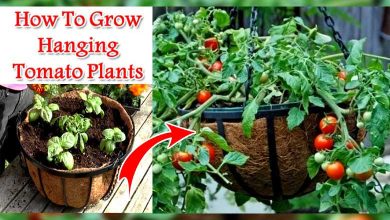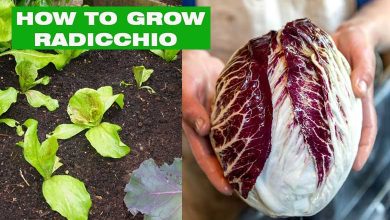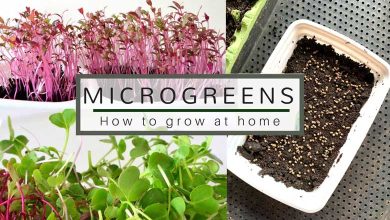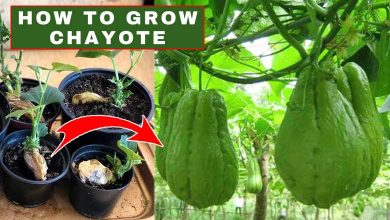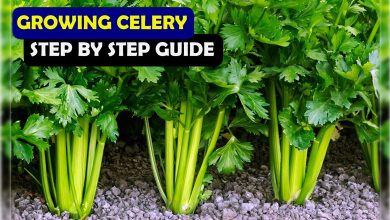How to Grow Aloe Vera from Leaf Expert Tips
To grow aloe vera from a leaf, cut a healthy leaf close to the base, let it dry for a few days, then plant it in well-draining soil and water sparingly. Growing aloe vera from a leaf is a simple and rewarding process. Aloe vera is a popular succulent plant known for its numerous health benefits and soothing gel. Whether you want to add it to your indoor garden or use it for various medicinal purposes, growing aloe vera from a leaf is an easy and cost-effective way to propagate new plants.
With a few simple steps, you can enjoy a constant supply of fresh aloe vera leaves right at home. Here are some success ideas as well as instructions on how to grow aloe vera from a leaf. So, See www.smallveggarden.com for more new plantings
Choosing The Right Aloe Vera Leaf For Propagation
Choosing the best leaf for propagation is the first step in growing aloe vera from leaves. To maintain healthy development and a flourishing aloe vera plant in your house or garden, follow these instructions. A well-liked and adaptable plant, aloe vera is well-known for its many health advantages. Using leaf cuttings to grow new plants of aloe vera is both economical and practical. Not all aloe vera leaves, meanwhile, are good for multiplication. The greatest aloe vera leaf to choose for healthy growth will be covered in detail in this section.
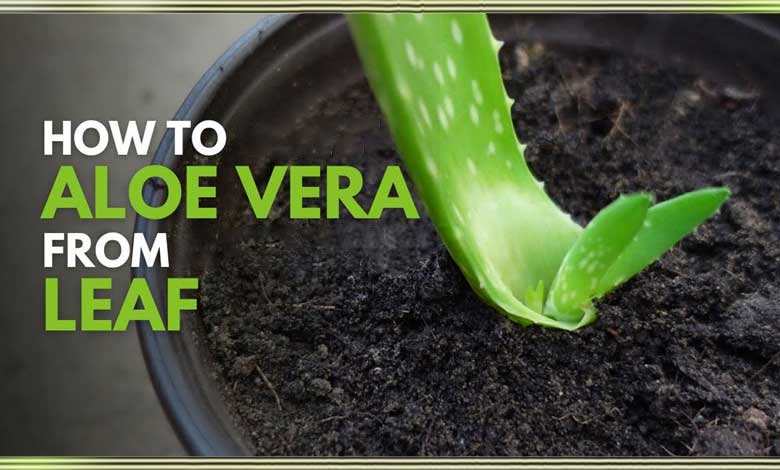
Selecting The Optimal Leaf For Successful Growth:
When it comes to propagating aloe vera from leaf cuttings, it is crucial to select a healthy leaf that is suitable for propagation. Consider the following important factors:
- Leaf size and maturity: Choose a leaf that is at least 3-4 inches long and fully matured. Avoid selecting smaller or younger leaves as they may not have enough nutrients to sustain the growth of a new plant.
- Leaf appearance: Look for leaves that are plump, firm, and free from any signs of disease or damage. Healthy leaves will have a vibrant green color and feel sturdy to the touch.
- Leaf position: It is recommended to choose a leaf from the bottom or middle of the plant. Leaves closer to the base of the plant tend to be older and have a higher chance of successful propagation.
- Leaf cut: When removing a leaf for propagation, use a clean and sharp knife to make a clean cut as close to the base of the plant as possible. Avoid tearing or damaging the leaf during the process.
- Leaf preparation: Once you have selected the appropriate leaf, allow it to dry for a few days in a warm and dry location. This will help seal the cut end and prevent rotting during the propagation process.
You may boost the likelihood of successful propagation and easily develop new plants by choosing the best aloe vera leaf with care. Remember to choose a healthy, mature leaf and prepare it properly before proceeding with the propagation process. Now that you have selected the ideal leaf, let’s move on to the next step in growing aloe vera from leaf cuttings.
Preparing The Aloe Vera Leaf For Propagation
To propagate aloe vera from a leaf, start by selecting a mature leaf from a healthy plant and gently cutting it at the base. Allow the cut end to dry before planting it in a well-draining potting mix, keeping it moist but not overly wet. The leaf itself will ultimately grow into a new growing aloe vera plant with proper attention and care. It’s rewarding to grow your own aloe vera plants from cuttings because it gives you a consistent supply of this useful and adaptable plant. It is essential to properly prepare the aloe vera leaf for multiplication.

We’ll cover two essential steps in this part for putting a leaf through its paces for propagation: cleaning and sterilizing it and cutting it for best outcomes.
Cleaning And Sterilizing The Leaf
Ensure an aloe vera leaf is clean and free of any potential pollutants before attempting to reproduce it. The likelihood of effective propagation increases, and the risk of disease is reduced when the leaf is cleaned and sterilized.
What to do is as follows:
- Gently clean the leaf using a damp cloth or sponge to remove any dirt or debris.
- Prepare a solution by mixing 1 part bleach with 9 parts water.
- Dip the cloth or sponge into the bleach solution and gently wipe the entire surface of the leaf, paying attention to both sides.
- Rinse the leaf thoroughly with clean water to remove any remaining bleach residue.
- Set the leaf aside to air dry completely before proceeding to the next step.
Properly Cutting The Leaf For Best Results
Cutting the aloe vera leaf properly is crucial for successful propagation. By following these steps, you can maximize your chances of growing new plants from the leaf:
- Select a healthy and mature leaf from a well-established aloe vera plant.
- Using a clean and sharp knife or scissors, cut the leaf as close to the base of the plant as possible.
- Allow the leaf to stand upright for 15-30 minutes to allow the yellow sap, known as aloin, to drain out. This sap can be harmful to the developing roots.
- After the sap has drained, use the knife or scissors to cut the leaf into individual sections. Each section should be 3-4 inches long.
- To prevent rotting, allow the cut ends of the sections to dry for 24-48 hours. This drying process helps seal the wound and promotes successful rooting.
Using these appropriate preparation methods can considerably increase your chances of successfully propagating aloe vera leaves. Clean and sterilize the leaf to minimize the risk of disease, and cut the leaf properly to promote healthy root development. Now that you’re prepared to continue growing aloe vera let’s discuss the accurate propagation procedure in the following part.
Propagating Aloe Vera Leaf
Aloe vera may be grown from a leaf to learn how to do it. With these simple steps, you can easily propagate a new aloe plant and enjoy all its healing benefits. Propagating an aloe vera plant from a leaf is a simple and affordable way to cultivate your own plants. In this method, a healthy leaf from an existing plant is used to grow a new one. Let’s look at the aloe vera leaf propagation procedure to give you all the information you need to succeed.
Preparing The Potting Mix For Rooting:
To give your aloe vera leaf the best chance of rooting and growing successfully, you need to prepare the right potting mix. Here’s what you need to do:
- Choose a well-draining mix: Aloe vera thrives in well-draining soil, so opt for a mix specifically designed for succulents or one that consists of equal parts of potting soil, sand, and perlite.
- Sterilize the mix: If using a pre-packaged mix, you may not need to sterilize it. However, if you’re using garden soil or recycled mix, bake it in the oven at 180°f (82°c) for 30 minutes to eliminate any potential pathogens.
- Ensure proper ph levels: Aloe vera prefers slightly acidic soil with a ph range between 6.0 and 7.0. Test the soil ph using a simple diy kit and adjust it if necessary.
Placing The Leaf In The Potting Mix:
Now that you have your potting mix ready, it’s time to propagate the aloe vera leaf. Here are the steps to follow:
- Select a healthy leaf: Choose a mature, thick leaf from a healthy aloe vera plant. Ensure the leaf is at least 3-4 inches long and has a clean cut at the base.
- Allow the leaf to heal: Before planting the leaf, let it dry for a couple of days. This step allows the cut end to callous over, reducing the risk of rot.
- Prepare a small pot: Use a small pot that has drainage holes to prevent waterlogged soil. Fill the pot with the prepared potting mix.
- Plant the leaf: Gently press the calloused end of the leaf about an inch into the potting mix. Ensure the leaf remains upright and stable.
Creating The Ideal Conditions For Rooting:
For successful rooting and growth, providing the ideal conditions is crucial. Here’s what you need to do:
- Place the pot in a bright location: Aloe vera thrives in bright, indirect sunlight. Find a spot near a window where the plant can receive adequate light.
- Avoid overwatering: Aloe vera is prone to root rot if overwatered. Water the plant only when the top inch of soil feels dry, and ensure the excess water drains well.
- Maintain moderate temperatures: Aloe vera prefers temperatures between 60°f (15°c) and 75°f (24°c). Avoid exposing the plant to extreme cold or hot temperatures.
- Provide good airflow: Aloe vera benefits from good air circulation. Place a small fan nearby or ensure the plant is not crowded by other objects.
By following these steps, you can successfully propagate aloe vera from a leaf and watch as your new plant takes root and flourishes. Happy gardening!
Caring For The Aloe Vera Cutting
To grow aloe vera from a leaf cutting, care is key. Ensure the cutting is healthy and calloused before planting it in well-draining soil. Keep it in a warm, sunny spot and water sparingly to prevent root rot.

Providing Adequate Sunlight And Temperature:
- Aloe vera plants thrive in bright, indirect sunlight. Place your cutting near a window that receives ample sunlight throughout the day.
- Ensure that the temperature around the aloe vera cutting ranges between 60°f (15°c) and 75°f (24°c), as this is the ideal temperature range for its growth.
- Protect the cutting from extreme heat or cold, as it may damage the plant. Keep it away from drafty areas or direct heat sources like radiators.
Watering And Moisture Management:
- Allow the soil to dry completely between watering sessions. Overwatering may lead to root rot and damage the plant.
- Water the aloe vera cutting deeply and thoroughly, ensuring that the soil is evenly moist. Then, let it drain completely to avoid waterlogging.
- Depending on the humidity and temperature in your area, water your cutting every 2-3 weeks during the warmer months, and reduce the frequency during winter.
Fertilizing And Nutrient Requirements:
- Aloe vera is a low-maintenance plant that does not require frequent fertilization. Apply a balanced and diluted fertilizer during the growing season, usually in spring and summer.
- Choose a fertilizer specifically formulated for succulents or cacti. Dilute it according to package instructions and apply it once every 2-3 months.
- Avoid over-fertilization as it can cause adverse effects on the aloe vera plant. Following the recommended dosage is crucial to prevent nutrient burn and other issues.
Remember, caring for your aloe vera cutting includes providing adequate sunlight and temperature, managing watering and moisture, as well as fulfilling its nutrient requirements through proper fertilization. With these essential guidelines in mind, your aloe vera cutting is on its way to growing into a healthy and vibrant plant.
Promoting Healthy Growth Of Aloe Vera Plants
Learn how to grow aloe vera from leaf and discover the secrets to encouraging healthy growth. You may care for your plants and make sure they thrive by following the instructions in this step-by-step manual. With a broad number of benefits, including the capacity to heal and purify the air, aloe vera is a low-maintenance plant.
It would be best to give your aloe vera plants the appropriate care and attention to guarantee their good growth. Pruning and grooming the plant, controlling pests and diseases, and repotting and transplanting the plant are three crucial parts of encouraging healthy growth that will be covered in this section.
Take a closer look at each of these subjects now:
Pruning And Grooming The Aloe Vera Plant:
- Remove dead or yellowing leaves: Gently trim off any dead or yellow leaves with a sharp, clean knife or shears. This will not only enhance the plant’s appearance but also promote new growth.
- Regularly remove offsets: Aloe vera plants produce tiny “babies” called offsets or pups around the base. Carefully detach these offsets and transplant them to propagate new plants or to prevent overcrowding.
- Cut back overgrown stems: If your aloe vera plant becomes tall and leggy, you can trim back the stem to encourage new growth from the base. Remember to sterilize your tools before pruning to prevent any potential disease transmission.
Managing Pests And Diseases:
- Prevent infestations: Maintain a clean and dry environment around your aloe vera plant to discourage pests like mealybugs and mites. Inspect the leaves regularly for any signs of infestation and take necessary measures promptly.
- Natural pest control: For minor infestations, consider using organic pest control methods such as diluted neem oil or a mild soap and water solution. Apply it to the affected areas with a soft cloth or spray bottle.
- Addressing diseases: Overwatering can lead to root rot, while excessive sunlight can cause sunburn or discoloration. Ensure you provide the right amount of water and adequate shade to prevent these issues. It’s also important to promptly address any signs of fungal infections, such as black spots or wilting leaves, by adjusting watering practices and improving air circulation.

Repotting And Transplanting Aloe Vera:
- Right time and container: Repot your aloe vera plant when it outgrows its current container. Choose a pot with drainage holes and use well-draining soil to prevent waterlogged roots. Spring is the ideal time to repot, as it aligns with the plant’s active growth phase.
- Gentle handling: Carefully remove the plant from its current pot and gently loosen the roots. Avoid excessive handling to prevent damage and shock to the plant.
- Transplanting offsets: If you have propagated new plants from offsets, ensure they have developed a healthy root system before transplanting them into their own pots. Follow the same repotting guidelines as mentioned above.
By following these tips for pruning and grooming your aloe vera plant, managing pests and diseases, and repotting and transplanting it correctly, you can foster healthy growth and enjoy the numerous benefits this versatile plant has to offer. Remember, consistent care and attention are key to keeping your aloe vera thriving.
Harvesting And Utilizing Aloe Vera
Discover the secrets of growing aloe vera from leaf with our simple step-by-step guide. Harvest and utilize this versatile plant for its numerous benefits, from soothing skin ailments to creating homemade skincare products. Start your own aloe vera garden and enjoy its natural healing properties.
Knowing When To Harvest Aloe Vera Leaves
Aloe vera is a plant known for its numerous health benefits, and harvesting its leaves at the right time is crucial to ensure optimal potency. Here are some pointers to help you determine when to harvest your aloe vera leaves:
- Age of the plant: Aloe vera plants should ideally be at least 3 years old before harvesting their leaves. This allows the plant to develop strong, mature leaves that are packed with beneficial gel.
- Color of the leaves: Mature aloe vera leaves have a vibrant green color. To identify a leaf that is ready for harvest, look for leaves that are at least 8 inches long and have a deep green hue.
- Feel of the leaves: Gently squeeze the leaves of your aloe vera plant. If they feel firm and plump, they are likely ready for harvest. Avoid harvesting leaves that are soft or yellow, as they may not contain as much gel.
- Time of day: Harvest your aloe vera leaves in the morning when the gel is most concentrated. This is because the plant accumulates moisture overnight, making the gel denser and more potent.
Safely Extracting Gel From Aloe Vera Leaves
Once you have harvested your aloe vera leaves, extracting the gel requires careful technique to ensure that you obtain the purest form without any impurities. Follow these steps for safe gel extraction:
- Wash the leaves: Begin by rinsing the harvested leaves with clean water to remove any dirt or debris. This step is essential to prevent contamination of the gel.
- Remove the thorns: Using a sharp knife, carefully remove the thorny edges of the leaves. Be cautious not to cut too deep, as you want to preserve as much of the gel as possible.
- Slice the leaf lengthwise: Lay the leaf flat on a cutting surface and slice it lengthwise. This will expose the gel-filled interior.
- Scoop out the gel: With a spoon or a scooping tool, gently scoop out the gel from the leaf. Take care to scrape off only the clear gel and avoid the yellowish sap, as it can cause irritation.
- Store the gel: Transfer the extracted gel into a clean container and store it in the refrigerator. This will help preserve its freshness and potency.
Beneficial Uses Of Aloe Vera Gel
An effective element with numerous benefits for both skincare and health is aloe vera gel. Here are some ways to make the most of your freshly extracted aloe vera gel:

- Skincare: Apply a thin layer of aloe vera gel on your face as a natural moisturizer. Dry skin can be relieved, and inflammation can be decreased because of its moisturizing qualities. Due to its antibacterial and therapeutic qualities, aloe vera gel can also treat minor burns, wounds, and bug bites.
- Haircare: Massage aloe vera gel into your scalp to promote healthy hair growth and reduce dandruff. To soften and improve the manageability of your hair, you may also use the gel as a natural hair conditioner.
- Digestive health: Consuming aloe vera gel orally can support digestive health. Acid reflux, indigestion, and irritable bowel syndrome symptoms are all lessened by their calming and anti-inflammatory effects.
- Immune boost: Aloe vera gel contains vitamins, minerals, and antioxidants that can help strengthen your immune system. Consuming a small amount daily may improve overall wellness and support your body’s natural defense mechanisms.
Remember, before using aloe vera gel for any particular health ailments or concerns, it is crucial to do extensive research and speak with a healthcare expert.
Frequently Asked Questions For How To Grow Aloe Vera From Leaf
How Long Does It Take For An Aloe Vera Leaf To Grow Roots?
It typically takes around 2-4 weeks for an aloe vera leaf to grow roots. However, this period may change based on environmental elements like humidity and temperature.
Can I Grow Aloe Vera From A Single Leaf?
Yes, you can grow aloe vera from a single leaf. Simply remove a mature leaf from the plant, let it callous over for a few days, and then plant it in well-draining soil. Be patient, as it takes time for the leaf to develop roots and establish itself.
Do Aloe Vera Plants Need A Lot Of Sunlight?
While aloe vera plants do require sunlight, they should not be placed in direct sunlight for extended periods. Ideally, they should be positioned in a spot that receives bright, indirect sunlight. Too much direct sunlight can cause the leaves to become sunburned.
How Often Should I Water My Aloe Vera Plant?
Aloe vera plants are succulents and are adapted to survive in dry conditions. Therefore, it’s important not to overwater them. Water your aloe vera plant only when the soil is completely dry, typically every 2-3 weeks. Ensure that the pot has proper drainage to prevent root rot.
Can I Use Regular Potting Soil For My Aloe Vera Plant?
No, it is not recommended to use regular potting soil for your aloe vera plant. They need soil that drains adequately to avoid root rot. Use a cactus or succulent soil mix, or create your own by mixing equal parts of potting soil, perlite, and coarse sand.
Last thing
Growing aloe vera from leaf can be a rewarding and fulfilling experience. With a few simple steps, you can propagate this versatile plant and enjoy its numerous benefits. Start by selecting a healthy leaf, allowing it to dry and then planting it in well-draining soil.
Regularly water your new plant but be cautious not to overwater, as aloe vera prefers dry conditions. As the plant grows, repot it into a larger container to accommodate its expanding root system. Remember to provide adequate sunlight and avoid exposing your aloe vera to extreme temperatures.
With patience and care, you can watch your aloe vera flourish and thrive. You’ll not only have a lovely addition to your house or garden, but you’ll also have access to a natural cure. So get started and enjoy the wonders of growing aloe vera from leaf!


